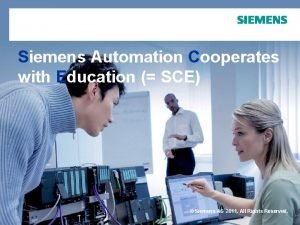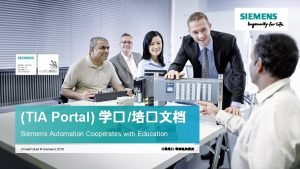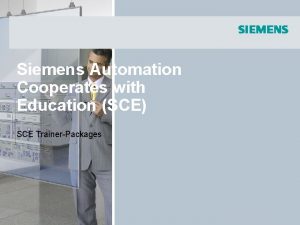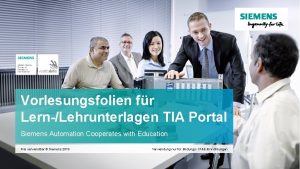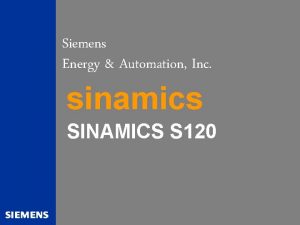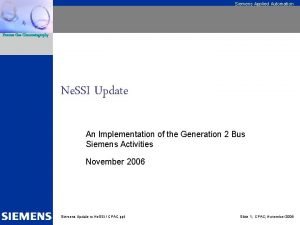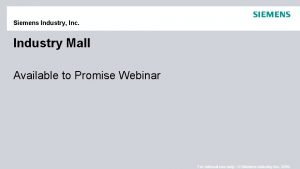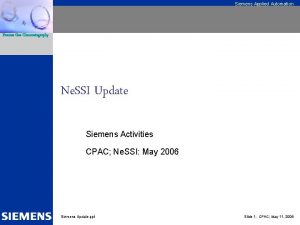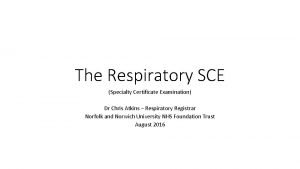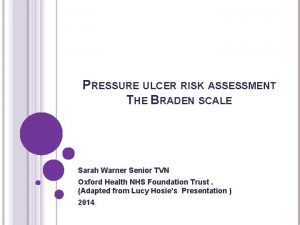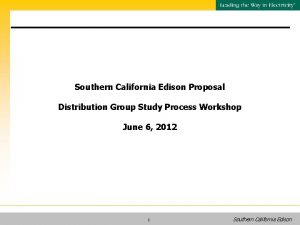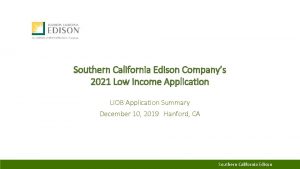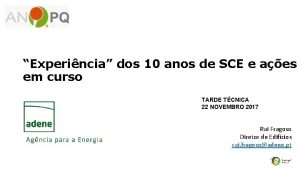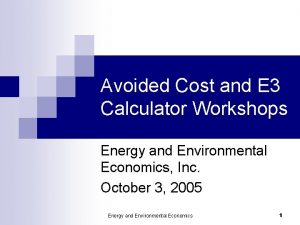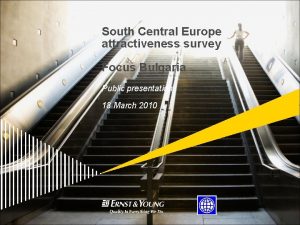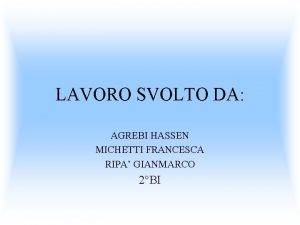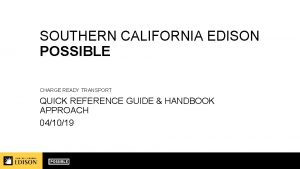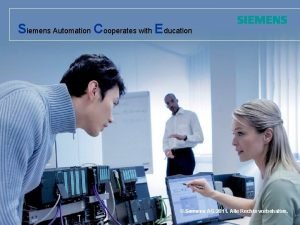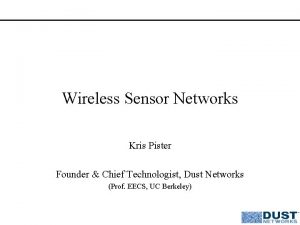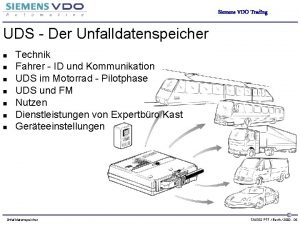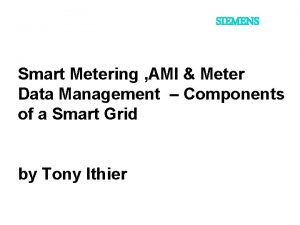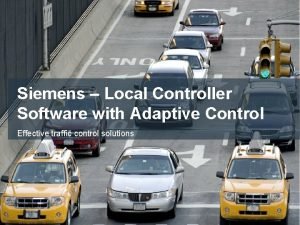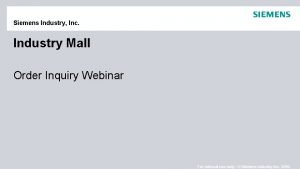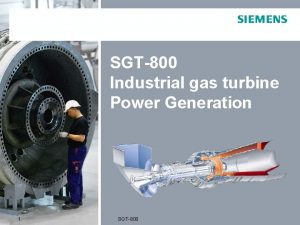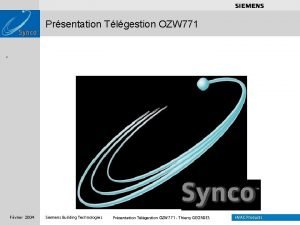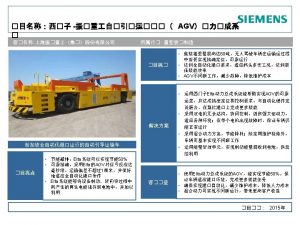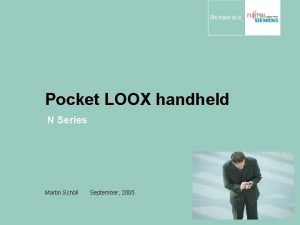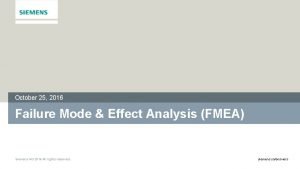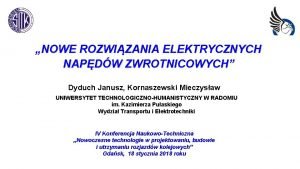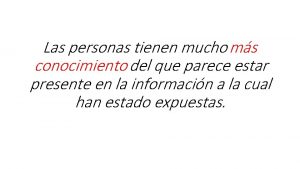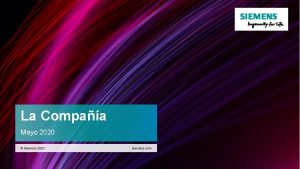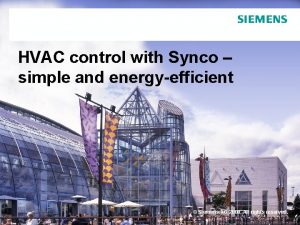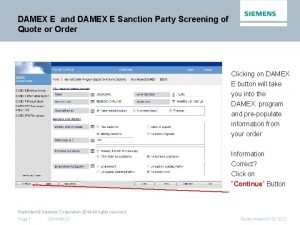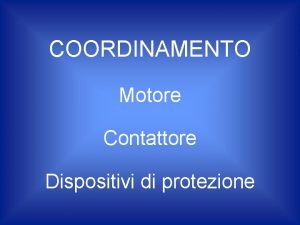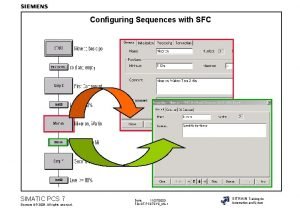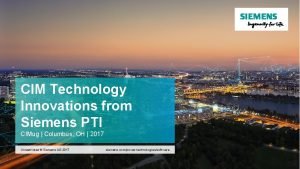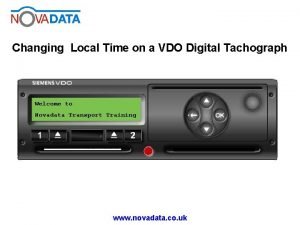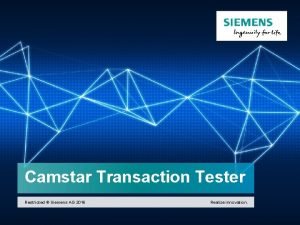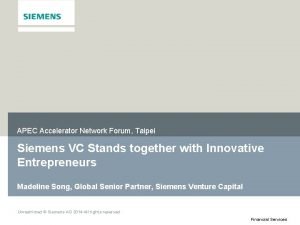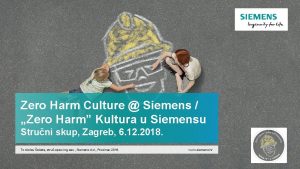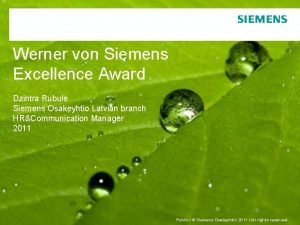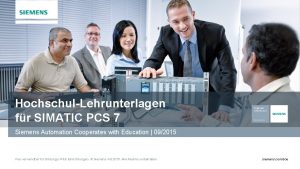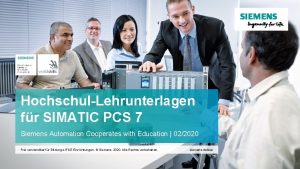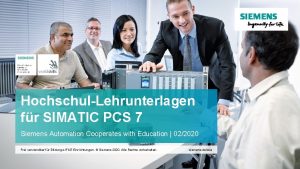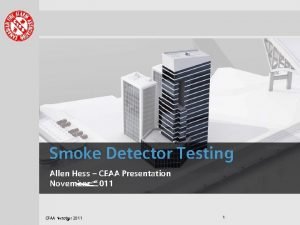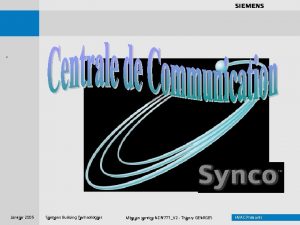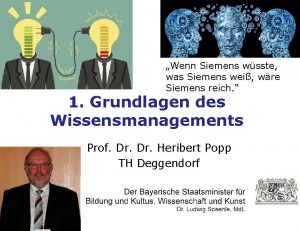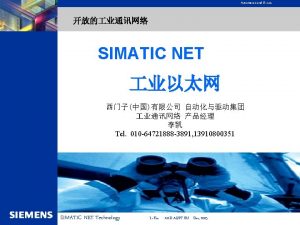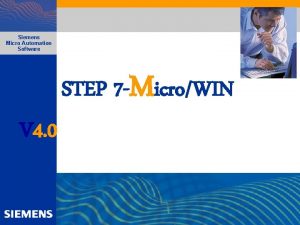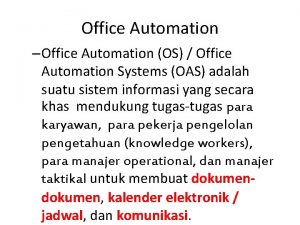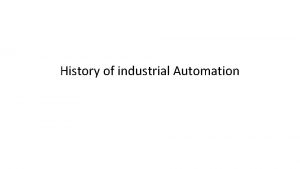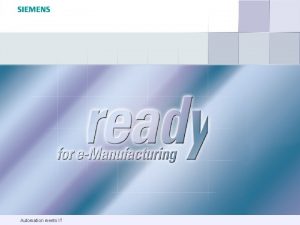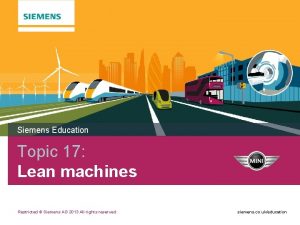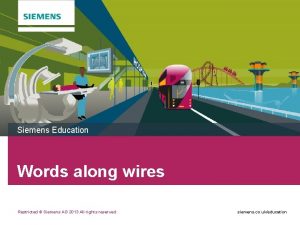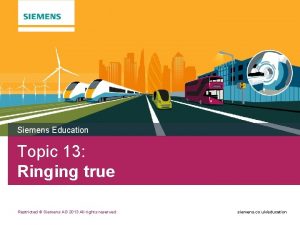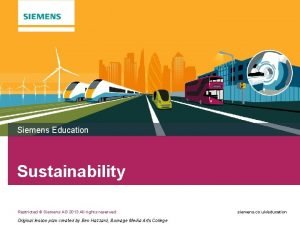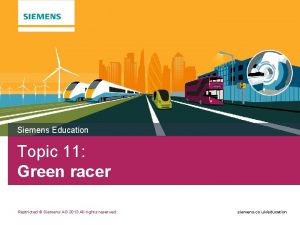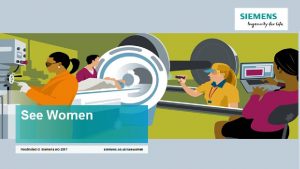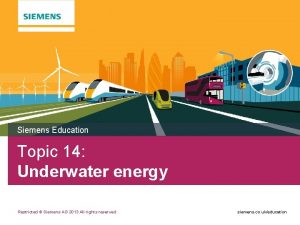Siemens Automation Cooperates with Education SCE Siemens AG














































- Slides: 46

Siemens Automation Cooperates with Education (= SCE) © Siemens AG 2011. All Rights Reserved.

Siemens Automation Cooperates with Education PCS 7 HS - Training Manuals Status: March 2011 PCS 7 HS Training Manuals P 01 -P 02_01_En_B. ppt © Siemens AG 2011. All Rights Reserved

PCS 7 Training Manuals Table of Contents Instruction MODULE 1 § P 01 -01 Process Description § P 01 -02 Hardware Configuration § P 01 -03 Plant Hierarchy § P 01 -04 Individual Drive Function § P 01 -05 Functional Safety § P 01 -06 Control Loop § P 01 -07 Sequential Function Chart Instruction MODULE 2 § P 02 -01 HMI Generation § P 02 -02 Alarm Engineering § P 02 -03 Importing Plant Design Data Page 3 © Siemens AG 2011. All Rights Reserved. Industry Sector

PCS 7 Training Manuals Module 1 P 01 -01 Process Description Objective § Classification of process engineering plants § P&ID flow diagram of the lab installation § Locks and recipes for the lab installation Page 4 © Siemens AG 2011. All Rights Reserved. Industry Sector

PCS 7 Training Manuals Module 1 P 01 -01 Process Description Classification of Process Engineering Plants § Classification according to the number of fundamentally different products § Single product plant § Multi-product plant § Classification according to the physical structure of the plant § Single line plant § Multi-line/multi path plant § Lab installation as learning example § Multi-product and multi-line/multi-path plant § Hierarchical breakdown into 4 units Page 5 © Siemens AG 2011. All Rights Reserved. Industry Sector

PCS 7 Training Manuals Module 1 P 01 -01 Process Description P&ID Flow Diagram of the Lab Installation Product tanks Rinsing Educt tanks Page 6 Reactors © Siemens AG 2011. All Rights Reserved. Industry Sector

PCS 7 Training Manuals Module 1 P 01 -01 Process Description Locks and Recipes § Safe operation of the plant requires monitoring the process interventions § Requirements for the lab installation: § Actuators can be activated only if the main switch is on and Emergency Off is unlocked § Protection of the tanks against overflow § Prevent air intake in the case of pumps § Pumps must not work against closed valves § … § Manufacturing a product requires a process specification § Recipe for the lab installation: § 350 ml from Educt 3 to Reactor 1 and 200 ml from Educt 1 to Reactor 2 § Heating Reactor 1 up to 25°C and 150 ml from Educt 2 to Reactor 2 … §… Page 7 © Siemens AG 2011. All Rights Reserved. Industry Sector

PCS 7 Training Manuals Module 1 P 01 -02 Hardware Configuration Objective § Theory § Distributed structures § Interfacing with the process § Operation principle of the PLC § Step-by-step instructions § Setting up a project § Configuring the hardware § Configuring the communication network Page 8 © Siemens AG 2011. All Rights Reserved. Industry Sector

PCS 7 Training Manuals Module 1 P 01 -02 Hardware Configuration Distributed Structures of Process Control Systems § Special structures lead to scalable process control systems § Structures are component based and thus easily expandable § Typical structure: § Process management level § Control level § Field level Page 9 © Siemens AG 2011. All Rights Reserved. Industry Sector

PCS 7 Training Manuals Module 1 P 01 -02 Hardware Configuration Interfacing with the Process § Two typical ways to interface encoders and actuators with the PCS § Directly by means of the bus system (intelligent devices) § By means of an electrical standardized signal to a signal module § Signal modules for § Binary signals: DI/DO modules (DI. . digital input, DO. . digital output) § 1 bit of memory is needed for each signal § Analog signals: AI/AO modules (AI. . analog input, AO. . analog output) § 16 bits of memory is needed for each signal § Resolution may be lower nevertheless; for example, 12 bits Page 10 © Siemens AG 2011. All Rights Reserved. Industry Sector

PCS 7 Training Manuals Module 1 P 01 -02 Hardware Configuration How the PLC works § Component on the control level is typically a PLC § Input and output signals are read in/read out cyclically and stored temporarily in the process image § Signal consistency during program processing by accessing the process image Page 11 © Siemens AG 2011. All Rights Reserved. Industry Sector

PCS 7 Training Manuals Module 1 P 01 -02 Hardware Configuration of the Lab Installation § AS § PS § CPU (with Profibus) § ET 200 M (with Profibus) § 4 x DI § 2 x DO § 1 x AI § 1 x AO § CP (with Ethernet) § ES/OS § PC (with Ethernet) Page 12 © Siemens AG 2011. All Rights Reserved. Industry Sector

PCS 7 Training Manuals Module 1 P 01 -03 Plant Hierarchy Objective § Theory § Structuring the lab installation § Deriving the visualization § Plant hierarchy of the plant and visualization structure § Step by step instructions § Calling the plant view § Setting up the plant hierarchy § Basic settings for the plant hierarchy Page 13 © Siemens AG 2011. All Rights Reserved. Industry Sector

PCS 7 Training Manuals Module 1 P 01 -03 Plant Hierarchy Structuring the Lab Installation § structuring using the functional aspect § hierarchical decomposition in units § unit 1: educt tanks § unit 2: reaction § unit 3: product tanks § unit 4: rinsing § design of a labelling system according to ISA-88 § site: SCE_factory § process cell: A 1 § unit: T 1. . T 4 § equipment module: pumps P 00 x, § valves V 00 x, levels L 00 x, § temperature T 00 x, agitator … Page 14 © Siemens AG 2011. All Rights Reserved. Industry Sector

PCS 7 Training Manuals Module 1 P 01 -03 Plant Hierarchy Deriving the Visualization § Visualization in the operator system (OS) is derived by using the following steps: § Structuring the lab installation § Setting up the plant hierarchy § Selecting a hierarchical level as OS area § Performing a generation run (see P 02 -01 HMI Generation) § All hierarchical levels below the level defined as OS area can be automatically displayed § Area IDs § Navigation hierarchy § Face plates for implemented templates § Group alarms Page 15 © Siemens AG 2011. All Rights Reserved. Industry Sector

PCS 7 Training Manuals Module 1 P 01 -03 Plant Hierarchy and the Effect on Visualization OS area Operating Screens Page 16 © Siemens AG 2011. All Rights Reserved. Industry Sector

PCS 7 Training Manuals Module 1 P 01 -04 Individual Drive Function Objective § Theory § Individual drive function (IDF) § IDF in PCS 7 § IDF motor § Step by step instructions § Setting up symbol tables § Setting up CFC for IDF motor § Testing the IDF Page 17 © Siemens AG 2011. All Rights Reserved. Industry Sector

PCS 7 Training Manuals Module 1 P 01 -04 Individual Drive Functions (IDF) § Hierarchical structuring of the plant according to ISA-88. 01 § Level 0: Individual control unit § Individual control unit is a recurring element § Project wide § Beyond projects § Can be reused § Advantages: § Parameterization instead of programming § Tested functionality § Uniform handling and visualization § Standardization of individual drive units § e. g. motor, valve, … Page 18 © Siemens AG 2011. All Rights Reserved. Industry Sector

PCS 7 Training Manuals Module 1 P 01 -04 Individual Drive Function in PCS 7 § Function blocks as object-oriented model of a technical installation § e. g. motors and valves § Functions: § Activation and operating modes § Protection and monitoring functions § Handling and visualization functions § Signaling and alarm functions § Function block as object-oriented model of a (measuring) signal § For example, digital output, digital input, analog output, analog input § Functions: § Scaling the digital value to the physical range § Monitoring the signal quality Page 19 © Siemens AG 2011. All Rights Reserved. Industry Sector

PCS 7 Training Manuals Module 1 P 01 -04 Individual Drive Function Motor (FB 66 in PCS 7 Standard Library) § Function blocks MOTOR § § Used for controlling pumps and stirrers in the lab installation § Features: § One control signal (on/off) § Monitoring by run feedback § Advantages: § No programming of control, protection and monitoring functions § Uniform parameters § Uniform visualization (see P 02 -01 HMI Generation) § Page 20 © Siemens AG 2011. All Rights Reserved. Industry Sector

PCS 7 Training Manuals Module 1 P 01 -04 Individual Drive Function Implementation of a Pump of the Lab Installation § Pump SCE. A 1. T 2 -P 001 to empty the reactor content § Pump is run by a motor § The motor has the following signals § One signal for control § One signal for run feedback § PCS 7 standard library § MOTOR Symbol Address Data Type Symbol Comment A 1. T 2. A 1 T 2 S 003. SO+. O+ I 6. 1 BOOL Pump outlet reactor R 001 Feedback on A 1. T 2. A 1 T 2 S 003. SV. C O 6. 3 BOOL Pump outlet reactor R 001 control signal Page 21 © Siemens AG 2011. All Rights Reserved. Industry Sector

PCS 7 Training Manuals Module 1 P 01 -05 Functional Safety Objective § Theory § Plant protection using PCT resources § Standardized circuits for plant safety § Designing a lock for the lab installation § Step by step instructions § Setting up a CFC for manual motor operation § Adding lock for the motor in the CFC § Interconnections among CFCs Page 22 © Siemens AG 2011. All Rights Reserved. Industry Sector

PCS 7 Training Manuals Module 1 P 01 -05 Functional Safety Plant Safety using PCT Resources § Securing process engineering plants against error states § In reference to process variables, three areas have to be differentiated Page 23 © Siemens AG 2011. All Rights Reserved. Industry Sector

PCS 7 Training Manuals Module 1 P 01 -05 Functional Safety Designing a Lock for the Pump of the Lab Installation § The pump must be turned on only if the main switch of the plant is switched on and the Emergency Off switch is unlocked. § The pump must not take in air; i. e. the level in the reactor has to be at least 50 ml § The pump must not work against closed valves; i. e. , at least one valve has to be open Symbol Address Data Type Symbol Comment A 1 H 001. HS+-. START I 0. 0 BOOL Switch on multi-purpose plant A 1 H 002. HS+-. OFF O 0. 1 BOOL Activate Emergency OFF A 1. T 2. A 1 T 2 L 001. LISA+. M IW 512 WORD Actual value level Reactor R 001 A 1. T 2. A 1 T 2 X 007. GO+-. O+ I 6. 5 BOOL Open/close valve … indication A 1. T 3. A 1 T 3 X 001. GO+-. O+ I 12. 3 BOOL Open/close valve … indication A 1. T 4. A 1 T 4 X 003. GO+-. O+ I 14. 5 BOOL Open/close valve … indication Page 24 © Siemens AG 2011. All Rights Reserved. Industry Sector

PCS 7 Training Manuals Module 1 P 01 -05 Functional Safety Standard Wiring for Plant Safety § Substitute analog value A 1. T 2. A 1 T 2 L 001. LISA+. M with binary value that is the result of the comparison with 50 ml § Functional table to design the combinatorial circuit A 1 H 001 A 1 H 002 A 1 T 2 L 001 > 50 ml A 1 T 2 X 007 A 1 T 3 X 001 A 1 T 4 X 003 LOCK 0 x x x 0 x x x 0 0 1 1 x x 1 1 1 1 x x 1 1 § Result after <<according to>> conjunctive normal form (CNF) is used to lock the pump Page 25 © Siemens AG 2011. All Rights Reserved. Industry Sector

PCS 7 Training Manuals Module 1 P 01 -06 Control Loop and More Ctrl Functions Objective § Theory § Structure of a control loop § PID controller § Controlling the temperature of the lab installation § Step by step instructions § Establishing more CFCs § Parameterizing a continuous controller § Output of the analog manipulated value as binary signal by means of a pulse generator Page 26 © Siemens AG 2011. All Rights Reserved. Industry Sector

PCS 7 Training Manuals Module 1 P 01 -06 Loop Control and More Ctrl Functions Structure of a Control Loop § Process variables have to hold or set certain values § Disturbance behavior: A certain value has to be held despite disturbances § Response to set point changes: Set point is to be reached in the dynamic and stable mode § The control loop works as follows: § Process value/controlled variable is measured by a sensor § Measured value is deducted from the set point and thus the deviation is calculated. § Based on the deviation, the controller calculates the manipulated value of the actuator § The actuator has an effect on the system Page 27 © Siemens AG 2011. All Rights Reserved. Industry Sector

PCS 7 Training Manuals Module 1 P 01 -06 Loop Control and More Ctrl Functions PID Controller § From the deviation, the control algorithm calculates the manipulated value § Process industry uses the PID algorithm up to 95% § P means proportional § Current manipulated value only depends on current deviation § I means integral § Current manipulated value depends on the sum of the last deviations § D means differential § Current manipulated value depends on the change in the deviation § Only 3 parameters (gain, reset time and derivative time) have to be set § Controller adjustment rules suitable for processes without dominant dead time § Method of Ziegler and Nichols § Chien, Hrones and Reswick Page 28 © Siemens AG 2011. All Rights Reserved. Industry Sector

PCS 7 Training Manuals Module 1 P 01 -06 Control Loop and More Ctrl Functions Temperature Control of the Lab Installation § Control loop § Process/control variable is A 1. T 2. A 1 T 2 T 001. TIC. M § Manipulated variable is A 1. T 2. A 1 T 2 T 001. TV. S § Set point is § determined by recipe § determined manually § locked (tracking) § Conditions for locking § Minimum level in the reactor has to be 200 ml § Maximum temperature is 60°C maximum Page 29 © Siemens AG 2011. All Rights Reserved. Industry Sector

PCS 7 Training Manuals Module 1 P 01 -07 Sequence Controls Objective § Theory § Structure of step sequences § Designing a sequential control system § Recipe of the lab installation § Step by step instructions § Setting up and editing sequential function charts (SFC) § Connecting SFC and CFC § Testing the SFC Page 30 © Siemens AG 2011. All Rights Reserved. Industry Sector

PCS 7 Training Manuals Module 1 P 01 -07 Sequence Controls Structure of Step Sequences § Alternating sequence of steps and transitions § First step: start step § Final step: end step § Structures: § Unbranched step sequence § Alternative branches § Parallel branches § Impermissible structures: § Uncertain sequence – accessibility not ensured § Partially stuck – internal infinite loop § Totally stuck – no permissible step enable condition § Step sequences can be processed once or cyclically Page 31 © Siemens AG 2011. All Rights Reserved. Industry Sector

PCS 7 Training Manuals Module 1 P 01 -07 Sequence Controls Design of a Sequence Control § Proven design method for sequence controls § State graphs § Connected, oriented graph § States shown as circles – can be linked to actions § State transitions shown as arrows – subject to transition conditions § Petri nets § Consists of locations and transitions § Locations as circles § Transitions as rectangles/cross bars § Parallel sequences can be mapped Page 32 © Siemens AG 2011. All Rights Reserved. Industry Sector

PCS 7 Training Manuals Module 1 P 01 -07 Sequence Controls Recipe of the Lab Installation § First, 350 ml are to be drained from educt tank =SCE. A 1. T 1 -B 003 into reactor =SCE. A 1. T 2 -R 001 and at the same time 200 ml from educt tank =SCE. A 1. T 1 -B 002 into the reactor =SCE. A 1. T 2 -R 002. § When reactor =SCE. A 1. T 2 -R 001 is filled, the liquid is to be heated to 25°C with the agitator switched on. § When reactor =SCE. A 1. T 2 -R 002 is filled, 150 ml from educt tank =SCE. A 1. T 1 -B 001 is to be added to reactor =SCE. A 1. T 2 -R 002. When this is completed, 10 s later the agitator of reactor =SCE. A 1. T 2 -R 002 is to be switched on. § When the temperature of the liquid in reactor =SCE. A 1. T 2 -R 001 has reached 25°C, the mixture is to be pumped from reactor =SCE. A 1. T 2 R 002 to reactor =SCE. A 1. T 2 -R 001. § Now, the mixture in reactor =SCE. A 1. T 2 -R 001 is to be heated to 28°C and then drained into product tank =SCE. A 1. T 3 -B 001. Page 33 © Siemens AG 2011. All Rights Reserved. Industry Sector

PCS 7 Training Manuals Module 2 P 02 -01 HMI Generation Objective § Theory § Concepts of representation § HMI generation in PCS 7 § Graphic of the lab installation § Step by step instructions § Generating the operator station (OS) in the SIMATIC Manager § Configuration environment Win. CC § Generating pictures using the Graphics Designer Page 34 © Siemens AG 2011. All Rights Reserved. Industry Sector

PCS 7 Training Manuals Module 2 P 02 -01 HMI Generation Concepts of Representation § Important aspects of representation § Organization of what is to be represented § Density of representation § Coding § Conspicuousness § Consistency § Basic structure of the display area according to VDI 3699 § Flow diagrams § Process control flow diagrams § Process engineering flow diagrams § Basic flow diagram, process diagram, piping and instumentation diagram (P&ID) Page 35 © Siemens AG 2011. All Rights Reserved. Industry Sector

PCS 7 Training Manuals Module 2 P 02 -01 HMI Generation in PCS 7 § Picture hierarchy can be derived directly from the plant hierarchy § Setting up a picture in the corresponding levels § Using the block icons of templates § Deriving the block icons from the plant hierarchy § Configuring different OS areas § For example, unit T 1 is monitored by Operator 1, T 2 to T 4 by Operator 2 § Monitor configuration § Representation for different resolutions, number and arrangment of monitors § Graphics Designer § Drawing the process images (static elements) § Linking dynamic elements with process variables Page 36 © Siemens AG 2011. All Rights Reserved. Industry Sector

PCS 7 Training Manuals Module 2 P 02 -01 HMI Generation Graphics of the Lab Installation § The hierarchy is to include levels 2 and 3 <<refer to Notes Page for translation of terms below>> § Overview display § Display of all units § Display of the most important information § Abstract § Area display § Representation of a unit § Representation of block icons of motors and valves § Representation based on the P&ID Page 37 © Siemens AG 2011. All Rights Reserved. Industry Sector

PCS 7 Training Manuals Module 2 P 02 -02 Alarm Engineering Objective § Theory § Signaling systems § Alarms and indications § Alarm management in PCS 7 § Step by step instructions § Integrating the monitoring and alarming blocks § Win. CC Signalling system § Representation of alarms and warnings on the operator station (OS) Page 38 © Siemens AG 2011. All Rights Reserved. Industry Sector

PCS 7 Training Manuals Module 2 P 02 -02 Alarm Engineering Signaling Systems, Alarms and Indications § Interface between process and operator § Early detection of deviations from the desired state § Target oriented intervention to restore the desired state § Alarm → Display of or report about the occurrence of an event that requires immediate operator action § Message → Display of or report about the occurrence of an event that does not require immediate operator action § Characteristics for selecting alarms § Relevant § Unambiguous § Timely § Prioritized § Understandable Page 39 © Siemens AG 2011. All Rights Reserved. Industry Sector

PCS 7 Training Manuals Module 2 P 02 -02 Alarm Engineering Alarm Management in PCS 7 § Function block for generating messages § Block icon to represent alarming states § Group alarms along the plant hierarchy § Representation and management of message lists Page 40 © Siemens AG 2011. All Rights Reserved. Industry Sector

PCS 7 Training Manuals Module 2 P 02 -02 Alarm Engineering Alarms for the Lab Installation § Monitoring the level § Monitoring the temperature § Using Meas_Mon (FB 65) from the folder Control of the PCS 7 Library V 71 § Monitoring a measured value (analog signal) § Parameters that can be set § Warning limit (high/low) § Alarm limit (high/low) § Representation of the block icon § In unit T 2_reaction § Placing and compiling Page 41 © Siemens AG 2011. All Rights Reserved. Industry Sector

PCS 7 Training Manuals Module 2 P 02 -03 Importing Plant Design Data Objective § Theory § Design of complex systems § Process tag type § Model § Step by step instructions § Importing plant design data using the import/export wizard § Importing plant design data in the process object view § Duplicating charts by generating process tag types/models Page 42 © Siemens AG 2011. All Rights Reserved. Industry Sector

PCS 7 Training Manuals Module 2 P 02 -03 Importing Plant Design Data Design of Complex Systems § Three general design principles § Principle of hierarchical arrangement § Plant hierarchy § Principle of modularization § Scope and complexity of function blocks, CFCs and SFCs § Principle of reuse § Process tag types and models § Reuse also implies the following § Use of proven solutions (standards) § Central modifiability § Tested implementation Page 43 © Siemens AG 2011. All Rights Reserved. Industry Sector

PCS 7 Training Manuals Module 2 P 02 -03 Importing Plant Design Data Process Tag Types and Models § Process tag type – CFC - corresponds to the level: individual control unit § Model - entire hierarchies – correspond to the levels Technical installation and unit Very individual Partial copying possible Creating types possible Page 44 © Siemens AG 2011. All Rights Reserved. Industry Sector

PCS 7 Training Manuals Module 2 P 02 -03 Importing Plant Design Data Process Tag Types and Models of the Lab Installation § Selecting similar individual control units § Pumps § A 1 T 1 P 001, A 1 T 1 P 002, A 1 T 1 P 003 and A 1 T 4 P 001 § A 1 T 2 P 001 and A 1 T 2 P 002 § Valves § A 1 T 1 V 001, A 1 T 1 V 002, A 1 T 1 V 003, . . , A 1 T 1 V 006 §. . . § Selecting similar technical installations § Containers § A 1 T 1 B 001, A 1 T 1 B 002 and A 1 T 1 B 003 § A 1 T 2 R 001 and A 1 T 2 R 002 § A 1 T 3 B 001 and A 1 T 3 B 002 Page 45 © Siemens AG 2011. All Rights Reserved. Industry Sector

Thanks for your attention ! www. siemens. com/sce © Siemens AG 2011. All Rights Reserved
 Siemens sce
Siemens sce Siemens cooperates with education
Siemens cooperates with education Sce siemens
Sce siemens Siemens sce unterlagen
Siemens sce unterlagen Siemens energy and automation
Siemens energy and automation Siemens chromatography
Siemens chromatography Siemens a&d mall
Siemens a&d mall Applied automation gc
Applied automation gc Speciality certificate examination in respiratory medicine
Speciality certificate examination in respiratory medicine Braden scale
Braden scale Sce wdat
Sce wdat Sce com esap program
Sce com esap program Sce e
Sce e Sdge
Sdge Attractiveness sce
Attractiveness sce Schede didattiche parafrasi scuola primaria
Schede didattiche parafrasi scuola primaria Licter scale
Licter scale Sce charge ready transport
Sce charge ready transport Education siemens
Education siemens Is als a non formal education
Is als a non formal education Different between health education and health promotion
Different between health education and health promotion Backbone of extension education
Backbone of extension education Battery siemens
Battery siemens Vdo trading
Vdo trading Siemens smart meters
Siemens smart meters Sepac spa
Sepac spa Siemens a&d mall
Siemens a&d mall Siemens teamfleet
Siemens teamfleet Siemens ozw771
Siemens ozw771 Zpmc agv
Zpmc agv Siemens loox n
Siemens loox n Siemens fmea
Siemens fmea Ebi switch 700
Ebi switch 700 Biografia de george siemens
Biografia de george siemens Bernd montag terra vision
Bernd montag terra vision Siemens synco pris
Siemens synco pris Siemens havc plant application
Siemens havc plant application Damex check
Damex check Tabella coordinamento protezione motori siemens
Tabella coordinamento protezione motori siemens Sfc pcs7
Sfc pcs7 Fahrudin mekic
Fahrudin mekic Digi tacho change time
Digi tacho change time Camstar app
Camstar app Vc desktop siemens
Vc desktop siemens Zero harm culture
Zero harm culture Anne banfield
Anne banfield Siemens future werner
Siemens future werner
